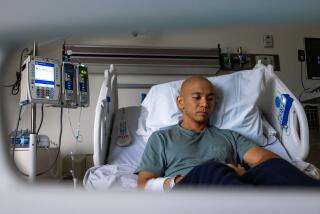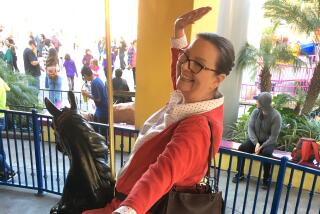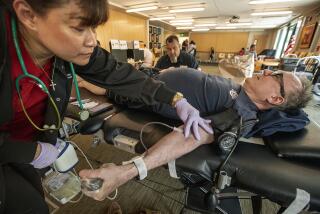After Tragedy, Sisterhood
- Share via
They share the most unlikely sisterhood, created by modern medical science but really forged in blood, trauma and finally tears.
Lina Joy of Paramount gave her bone marrow so that Santo Caratozzolo of Perth, Australia, might live. Instead, she nearly died when a rare staph infection attacked her marrow after the donation procedure at an Orange County hospital. She suffered liver, colon and kidney failure, and fell into a deep coma, all from drugs used to treat the deep-rooted infection.
The transplant did Caratozzolo little good either: He died within three months of receiving the marrow, before Joy even got out of the hospital.
From the compound tragedy, though, came a unique friendship for Joy and Caratozzolo’s widow, Diane. They met Tuesday for the first time at Los Angeles International Airport in an emotional catharsis, more than two years after Santo Caratozzolo received Joy’s marrow.
Crying in each other’s arms, hugging repeatedly, the two bridged the gap of time in an instant. The families then went to the Joys’ home for an extended get-together.
“She is my husband’s savior,” said Caratozzolo, 40, still insisting on holding Joy’s hand three hours later. “Without her, he wouldn’t have had a chance at all.”
The bond between the two women seems almost mystical. They finish each other’s sentences, and both refuse to dwell on the negatives of the death, comas and severe illnesses that brought them together.
“There is a link between our spirits as well as our blood,” said Joy, 45, her voice cracking. “For me, when I gave Santo my marrow, he became part of my family. Through Santo, Diane has become a sister to me.”
The families--including Caratozzolo’s three children and Joy’s husband, Governor--have been corresponding by mail and talking by phone since June 1998, three months after Santo’s death at 42.
Though Governor Joy, 46, knew that Lina’s marrow recipient had not survived, he did not tell her until after she had left the hospital for the fourth time and was home recuperating in May. The National Marrow Donor Program acts as a conduit for anonymous messages between donors and recipients, an arrangement the Joys and Diane Caratozzolo soon transcended.
There first conversation was by cell phone, and it led to the meeting Tuesday. “I wanted to catch up with this one,” said Caratozzolo, ducking her head onto Lina Joy’s shoulder as they shared a sofa in the Joys’ living room.
Santo, who had leukemia, also got an infection from the marrow, and though he rallied and was able to leave the hospital for a week, he died March 14, 1995. “It looked like [the treatment] was working,” Caratozzolo said. “He did get out for Valentine’s Day, for a couple of days, and that was his gift.”
Caratozzolo feels no guilt about Joy’s illness. “It angers me how it has gone,” she said. “This shouldn’t happen in this day and age to someone who is doing something for someone else.”
Joy’s case is the most serious complication to a donor ever experienced in the 12-year history of the National Marrow Donor Program, though four people have died in other situations, mostly involving donors overseas.
Joy continues to live with pain, a limp from where the infection ate away her hip and a lisp that appeared after her coma. She has unexplained rashes, a lupus-like condition and must avoid the sun because she lost pigmentation in her skin. Six weeks ago she had her ovaries removed because tumors formed there, apparently from the massive doses of anti-inflammatory drugs she took.
As the families chatted Tuesday, they traded on another tie, their firsthand experience with physicians and illness. Caratozzolo and Governor Joy shared stories about the wisdom of being vigilant in the hospital, the need to check charts and medications, and about having a refrigerator full of drugs and a house full of medical equipment.
“It is very draining,” Caratozzolo said.
At one point, Joy rolled up the sleeve of her white blouse to show the blotches that mar her once tanned arms.
“Oh, my God,” said Caratozzolo, her brown eyes tearing.
Despite the tragedy, Joy says she would urge her children to be donors.
Caratozzolo feels the same. She gives blood regularly and is a registered marrow donor herself.
“It would be a gift to give someone that chance,” she said. “I understand exactly what they need.”
Remarkably, both families relish the positives in the experience.
“I choose to believe that this is all part of a plan and good will come from all of it,” Lina Joy said. “This today is a blessing, and had I not gone through this, none of this would be happening.”
As the two “sisters” looked at each other, Joy went on. “We cannot be Lone Rangers. God didn’t put us on earth to be by ourselves.”
Then, at virtually the same time, they both said: “We have got to look at the positives.”
More to Read
Sign up for Essential California
The most important California stories and recommendations in your inbox every morning.
You may occasionally receive promotional content from the Los Angeles Times.










